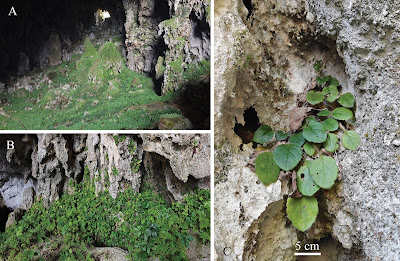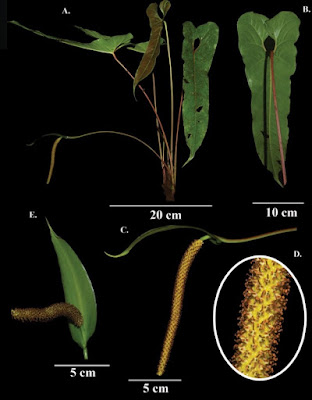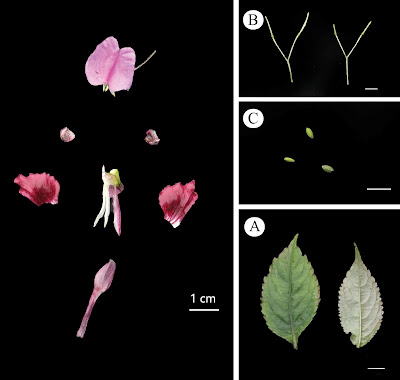[Most Recent Entries] [Calendar View]
Tuesday, July 29th, 2025
| Time | Event | ||||||
| 2:12a | [Botany • 2025] Petrocodon parviflorus (Gesneriaceae) • A New Species identified by both morphological and molecular evidence from limestone caves in Guangxi, China
Abstract Petrocodon parviflorus, a new species of Gesneriaceae, is a typically cave-dwelling species from the limestone region in Guangxi, China. Morphologically, this new species resembles P. lui, but can be readily distinguished by differences in corolla limb lobe shape, calyx lobe surface texture, pistil style length, and central staminode length. Molecular evidence supports its close phylogenetic relationship with P. lui despite their morphological distinctness. Based on the IUCN Red List Categories and Criteria, this species is assessed as Vulnerable (VU, D2). Key words: ITS, limestone flora, molecular phylogeny, Petrocodon, taxonomy, trnL-F
Petrocodon parviflorus F.Wen & K.Tan, sp. nov. Diagnosis. The new species resembles P. lui in leaf blade shape, but can be easily distinguished from the latter by corolla limb lobes oval (vs. oblong, obovate to suborbicular), longer style length 10–11.5 mm long (vs. 4–6 mm long), longer central staminode 1–1.3 mm long (vs. 0.5–0.8 mm long), calyx lobes sparsely puberulent abaxially (vs. glabrous abaxially). Etymology. The epithet ‘parviflorus’ reflects the relatively small flowers. The corolla is distinctly smaller compared to other species previously classified under the former Lagarosolen W.T.Wang, particularly L. lui Yan Liu & W.B.Xu (syn. Petrocodon lui). Vernacular name. 小冠石山苣苔 (Chinese pronunciation, Xiáo Guàn Shí Shān Jù Tái). Rui-Ning Liu, Ke Tan, Ping-Ya Chen, Xin-Xiang Bai, Chi Xiong, Song-Tao He and Fang Wen. 2025. Petrocodon parviflorus (Gesneriaceae), A New Species identified by both morphological and molecular evidence from limestone caves in Guangxi, China. PhytoKeys. 260: 201-212. DOI: doi.org/10.3897/phytokeys.260.153384 | ||||||
| 2:57a | [Botany • 2024] Anthurium dairon-cardenasii (Araceae) • A New Species of Anthurium sect. Belolonchium for Colombia
Abstract A new species of Anthurium Schott (Araceae) is described, belonging to section Belolonchium (Schott) Engl. Anthurium dairon-cardenasii López-Flor., Croat & Marco Correa is dedicated in honor of the great botanist Dairon Cardenas López, who dedicated his life to the study of the Amazon. The species was recorded in Caquetá, Colombia, in a lower montane wet forest in the framework of the Caquetá BIO project. KEYWORDS: Andes Mountains, Anthurium, Caquetá, section Belolonchium. Anthurium dairon-cardenasii López-Flor., Croat & Marco Correa. Oscar Mauricio López-Floriano, Thomas B. Croat, Marco Aurelio Correa-Munera, María Raquel Millán Marroquín. 2024. Anthurium dairon-cardenasii, A New Species of Anthurium sect. Belolonchium (Araceae) for Colombia. Novon: A Journal for Botanical Nomenclature. 32(1); 33 - 38. DOI: doi.org/10.3417/2024870 | ||||||
| 9:00a | [Arachnida • 2025] Phlogiellus khampheng • A New Species of Southeast Asian Dwarf Tarantula in the Genus Phlogiellus Pocock, 1897 (Araneae: Theraphosidae: Selenocosmiinae) from Lao PDR
Abstract A new species of Southeast Asian dwarf tarantula, Phlogiellus khampheng Sriranan, Songsangchote & Chomphuphuang, sp. nov., is described from Pakse, Champasack Province, Lao PDR. The species is placed within the Yamia group of the genus Phlogiellus, which is characterized by the absence of maxillary lyra. Phlogiellus khampheng Sriranan, Songsangchote & Chomphuphuang, sp. nov. can be distinguished from other species within the Yamia group by the unique morphology of the female spermathecae and the male embolus. The habitat and natural history of P. khampheng Sriranan, Songsangchote & Chomphuphuang, sp. nov. are also discussed, with specimens found in mixed deciduous forests near Pakse, Lao PDR, inhabiting various microhabitats such as soil walls, under rocks, and within tree hollows. An updated comparison of scopula characteristics and labial cuspule counts across Phlogiellus species highlights the variability of these traits and their limitations as diagnostic features. Molecular phylogenetic analyses and species delimitation methods (ABGD and ASAP) further support the recognition of P. khampheng Sriranan, Songsangchote & Chomphuphuang, sp. nov. as a distinct species. Key words: Distribution, Mygalomorphae, Tarantula, Taxonomy, Theraphosidae, Yamia
Phlogiellus khampheng Sriranan, Songsangchote & Chomphuphuang, sp. nov. Diagnosis. Phlogiellus khampheng sp. nov. was included in Phlogiellus based on the presence of a strong single retrolateral keel on the male embolus and a third claw on leg IV. P. khampheng sp. nov. is classified in the Yamia group (Kishida 1920) of Phlogiellus, similar to P. aper, P. birulai, P. brevipes, P. bundokalbo, P. daweiensis, P. longipalpus, P. moniqueverdezae, P. mutus, P. quanyui, P. raveni, and P. watasei due to the absence of maxillary lyra in female specimens. The P. khampheng sp. nov. differs from P. aper, P. birulai, P. brevipes, P. daweiensis, P. longipalpus, P. mutus, and P. watasei in having all metatarsal scopulae undivided, and differs from P. raveni and female P. bundokalbo in tarsal scopula division (divided on tarsus II, III and IV). The male P. khampheng sp. nov. differs from P. brevipes, P. daweiensis, P. moniqueverdezae, P. quanyui, P. raveni, and P. watasei, except P. longipalpus, by having a longer and more slender embolus with a distinct curve (Fig. 8). It can be further distinguished from P. moniqueverdezae by the narrower width at the base of the embolus. P. khampheng sp. nov. can also be distinguished from P. moniqueverdezae by geographical distribution with P. moniqueverdezae being found nearly 1,000 km away across the Gulf of Thailand. Furthermore, the male P. khampheng sp. nov. can be distinguished by the angle between the lowest and highest point of the embolus (ALH), which is 59°, compared to 77° in P. longipalpus and 44° in P. moniqueverdezae (Fig. 8). The female of P. khampheng sp. nov. differs from all other species in the Yamia group in the shape of the female spermathecae (Except female P. aper does not have described) which are twin receptacles with sub-apical buds (Fig. 6). Etymology. The species name “Khampheng” originates from the Lao and Thai languages, particularly in the Northeastern region, where it is used as a term of endearment to refer to someone who is cherished and precious to the speaker. The word carries a strong connotation of deep affection and high esteem, and it is often used in a loving and respectful manner when addressing or describing a person of great importance in one’s life. By choosing this name, the authors sought to convey the special and valuable relationship between Thailand and Laos, the two countries that collaborated closely in the discovery of this remarkable new tarantula species. “Khampheng” symbolizes the mutual respect, friendship, and cooperation that enabled the two nations to work together in advancing our understanding of the natural world and the incredible biodiversity it contains. Patipan Sriranan, Chaowalit Songsangchote, Odeth Sihavong, Phoukhanh Sayavongsa, Keolamphanh Sidavong, Lilammone Satakoun, Khamla Inkhavilay, Narin Chomphuphuang and Ray Gabriel. 2025. A New Species of Southeast Asian Dwarf Tarantula in the Genus Phlogiellus Pocock, 1897, from Lao PDR (Theraphosidae, Selenocosmiinae). ZooKeys. 1247: 19-43. DOI: doi.org/10.3897/zookeys.1247.155398 | ||||||
| 9:18a | [Arachnida • 2020] Pholcus tongyaoi • Notes on Two closely related Spider Species of the Pholcus phungiformes species group (Araneae: Pholcidae) from Beijing, China
Abstract The Pholcus phungiformes species group is highly diverse and currently contains 53 species. In this study, Pholcus tongyaoi Wang & Yao, sp. nov. (male, female) from Huairou District, Beijing, China is described while similar congener Pholcus lexuancanhi Yao, Pham & Li, 2012 from neighboring Haidian District (type locality) is redescribed; the female of P. lexuancanhi is described for the first time. In addition, the DNA barcode COI for the two species was obtained to estimate p-distance. Keywords: daddy-long-leg spider, DNA barcode, morphology, Pholcinae, taxonomy
Pholcus tongyaoi Wang & Yao, sp. nov. Xiang Wang, Shumaila Shaheen, Qiaoqiao He and Zhiyuan Yao. 2020. Notes on Two closely related Spider Species of the Pholcus phungiformes species group (Araneae, Pholcidae) from Beijing, China. ZooKeys. 965: 1-16. DOI: doi.org/10.3897/zookeys.965.56199 | ||||||
| 2:32p | [Botany • 2025] Impatiens meishanensis (Balsaminaceae) • A New Species from Sichuan, China Abstract Impatiens meishanensis K.Huang & Z.X.Fu, sp. nov., a new species of Balsaminaceae from Meishan City, Sichuan Province, China, is described and illustrated. The complete chloroplast (cp) genome of I. meishanensis is 152,104 bp in length. Based on phylogenetic analysis of the complete cp genome, I. meishanensis represents a distinct species closely related to Impatiens faberi Hook.f. The new species can be distinguished from the latter by its unique morphological characteristics: lower sepal gable-boat-shaped (vs. funnel-shaped), spur straight (vs. curved), flower large, ca. 4 cm long (vs. ca. 3 cm long), and seeds ellipsoid with reticulate seed coat ornamentation (vs. oblong, smooth). In addition, a distribution map, a detailed morphological comparison with related species, and an assessment of the conservation status of this newly identified species are provided. Key words: Impatiens, new species, morphology, phylogeny
Yanru Zhang, Xinyu Chen, Tianmeng Qu, Xinyi Zheng, Bo Li, Jieli Yue, Xiaoqin Liu, Min Pan, Ke Huang and Zhixi Fu. 2025. Impatiens meishanensis (Balsaminaceae), A New Species from Sichuan, China. PhytoKeys. 260: 97-113. DOI: doi.org/10.3897/phytokeys.260.150685 |
| << Previous Day |
2025/07/29 [Calendar] |
Next Day >> |













